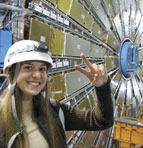Commentary: Kate McAlpine
 |
| Photo courtesy of Kate McAlpine |
Rapping physics
A good portion of the public is curious about what is going on in particle physics right now, and we have an ever-longer list of ways for them to find out—from lab newsletters to personal blogs, popular-level magazines, and plain-language Web sites.
CERN TV has been experimenting with YouTube since last October, and in late July, my colleagues and I put particles to music in the Large Hadron Rap, a slightly goofy project aimed at educating people about CERNs Large Hadron Collider on the French-Swiss border (to the extent that this is possible in five minutes!)
I think rap is a good way to communicate. Rhyme has always helped embed words in my mind; hopefully science rap can help cement ideas in the minds of students and other interested people. Nerdcore has been on the Web for a while, fusing nerdy from the cultures of video games and hard science with the hardcore of rock and hip-hop.
This was not my first science rap; in 2007 I enlisted fellow interns to perform in N3UROCH!P, based on the work of two physicists in Tel Aviv who imprinted rudimentary memories on neurons. Colleagues, bosses, and friends have been anywhere from baffled to amused at my physics-rap efforts, but overall Ive had a lot of help and support.
At CERN, Katie Yurkewicz, whose position as US LHC communicator I borrowed while she was on maternity leave, also lent me her camera to film the dancing. James Gillies, head of the press office, helped convince the ATLAS secretariat to let us film in the cavern. Fellow science communicators were a bit dubious about dancing at first, but they made it fun with their experimental moves. Will Barras, a linguistics student at the University of Edinburgh, made the 90s party rap backing track and mixed my voice.
The raps surprising popularity started with Adam Yurkewicz posting it on the US LHC blog, where a reporter for The New York Times saw it and ran a story. Other newspapers and radio stations began picking it up, blogs spread the word, and it garnered millions of hits, along with translations into a number of languages.
Two weeks after the Large Hadron Rap went online, Jonathan Chase, a science communication student in Wales, posted Astrobiology 2008—Infotainment, a rap about the study of life in the universe that had been commissioned by NASA. It was also picked up by the press and has had tens of thousands of views on YouTube.
Jonathan and I both hope to see more science rap. Maybe its just a flash in the pan, or maybe this will become another way to get the word out about scientific ideas and research.
One of the challenges in communication and outreach is that its often undervalued. Funding can seem hard to justify because already-limited budgets are intended to support research. The US LHC bloggers arent paid for the thought and time they put into posts. Volunteers often guide public lab tours, and physicists involved in outreach work usually do it on their own time.
This is part of the beauty of enthusiasm. Nevertheless, it would be nice if scientists who write about their work on blogs or craft articles for an outreach Web site could see those efforts valued on an equal footing with the hours they spend coding software, for instance.
It would be nice if we didnt have to decide between hiring an intern to create a public Web site and spending that money directly on an experiment. But without the Web site, information about the experiment just wouldnt be as readily available to members of the general public, and this would be a greater loss than some scientists realize.
On the other hand, most major laboratories do hire professional communicators and outreach coordinators. Im glad to see that at CERN, at least, even the individual experiments are beginning to hire people who can make their outreach pages more readable and aesthetically pleasing.
Communication is vital for a field that requires large investments of public money. To keep this interesting and valuable research funded, we need scientifically aware citizens and politicians. We need to keep putting information out at a level that people without specialized training can understand, appreciate, and maybe even dance to.
Science communicator Kate McAlpine writes about the Large Hadron Colliders ATLAS experiment for ATLAS e-News. Her nom de rap is alpinekat.
Click here to download the pdf version of this article.


